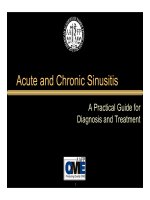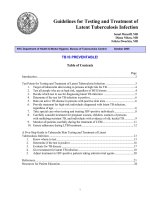Analgesics for pediatric pain treatment
Bạn đang xem bản rút gọn của tài liệu. Xem và tải ngay bản đầy đủ của tài liệu tại đây (420.83 KB, 42 trang )
ANALGESICS FOR
PEDIATRIC PAIN TREATMENT
Tran Thi Thanh Vui
05/04/2011 1
• Definition
• Classification
• Assessment
• Pharmacology of different analgesics
2
Definition of Pain
• International Association for the Study of Pain
– An unpleasant sensory and emotional
experience arising from actual or potential
tissue damage or described in terms of such
damage
3
Barriers to Pediatric Pain Control
• Children, especially infants, do not feel
pain the way adults do
• Lack of routine pain assessment
• Lack of knowledge in pain treatment
• Fear of adverse effects of analgesics,
especially respiratory depression and
addiction
• Preventing pain in children takes too
much time and effort
Pediatrics, 18 (3) 2001
4
Classification of Pain
Nociceptive
• Somatic
– Bone, joint, muscle, skin, or
connective tissue
– Well localized
– Aching & throbbing
• Visceral
– Visceral organs such as GI
tract
– Poorly localized
– Cramping
Neuropathic
• Central
– Injury to peripheral or
central nervous system
causing phantom pain
– Dysregulation of the
autonomic nervous system
• Peripheral
– Peripheral neuropathy due
to nerve injury
– Pain along nerve fibers
/>5
Pain Assessment
• Obtain a detailed assessment of pain
Quality, location, duration, intensity, radiation,
relieving & exacerbating factors, & associated
symptoms
• Many scales available
– NIPS (Neonatal Infant Pain Scale)
– FLACC scale (Face, Legs, Activity, Cry Consolability)
Directly ask child when possible
• Pain can be multi-dimensional and therefore,
tools can be limited
6
Assessment in Neonates & Infants
• Challenging
• Combines physiologic and behavioral
parameters
• Many scales available
– NIPS (Neonatal Infant Pain Scale)
– FLACC scale (Face, Legs, Activity, Cry
Consolability)
7
Neonatal Infant Pain Scale (NIPS)
8
FLACC scale
9
Children between 3-8 years
• Usually have a word for pain
• Can articulate more detail about the
presence and location of pain; less able
to comment on quality or intensity
• Examples:
– Color scales
– Faces scales
10
Children older than 8 years
• Use the standard visual analog scale
• Same used in adults
11
Children with Cognitive
Impairment
• Often unable to describe pain
• Altered nervous system and experience
pain differently
• Use behavioral observation scales
– e.g. FLACC
• Can apply to intubated patients
12
Analgesics
13
Principles of Pharmacology
• Consider patient’s age, associated medical
problems, type of pain, & previous experience
with pain
• Choose type of analgesia
• Choose route to control pain as rapidly and
effectively as possible
• Titrate further doses based on initial response
• Anticipate side effects
• Recognize synergistic effects
14
Routes of Analgesics
• Administer analgesia through most
painless route
– Avoid IM injections
– Oral and Intravenous routes are preferred
• Oral route for mild to moderate pain
• Intravenous route for immediate pain relief and
severe pain
15
16
NEJM 2002; 347 (14).
• Step 1 (1-3): acetaminophen, NSAIDs
• Step 2 (4-6): codeine, tramadol,
hydrocodone, oxycodone
• Step 3 (7-10): morphine, oxycodone,
fentanyl, methadol
17
Non-opioid Analgesics
• Mild to moderate pain
• No side effects of respiratory depression
• Highly effective when combined with opioids
•
•
•
•
Acetaminophen
NSAIDs
COX-2 inhibitors
Aspirin
– No longer used in pediatrics
18
Acetaminophen
• Antipyretic
• Mild analgesic
• Administer PO or PR
• Pediatric Oral dose 10-15 mg/kg/dose
every 4 hr
– Infant dose is 10-15 mg/kg/dose every 6-8 hr
– Adult dose 650 mg-1000 mg/dose
• Onset 30 minutes
19
Acetaminophen
• Per rectum dose 40 mg/kg once followed
by 20 mg/kg/dose every 6 hours
– Uptake is delayed and variable
– Peak absorption is 60-120 minutes
• Maximum daily dosing
– Infants: 60-75 mg/kg/day
– <60 kg: 100 mg/kg/day
– >60 kg: 4 grams/day
20
Side Effects of Acetaminophen
• Generally a good safety profile
– Do not use in hepatic failure
• Causes hepatic failure in overdose
• Combination medicines
• Infant’s Acetaminophen drops 80 mg/0.8 mL;
120mg/ml
• Children’s Acetaminophen suspension 160 mg/5 mL
21
NSAIDs
• Antipyretic
• Analgesic for mild to moderate pain
• Anti-inflammatory
– COX inhibitor Prostaglandin inhibitor
• Platelet aggregation inhibitor
22
NSAIDs: Ibuprofen
• Dose 10 mg/kg/dose every 6 hours
– Adult dose 400-600 mg/dose every 6 hours
• Onset 30-45 minutes
• Maximum daily dosing
– <60 kg: 40 mg/kg
– >60 kg: 2400 mg
• May use higher doses in rheumatologic disease
23
NSAIDs: Ketorolac
• Intravenous NSAID (also available P.O.)
• Dose 0.5 mg/kg/dose every 6 hours
• Onset 10 minutes
• Maximum I.V. dose 30 mg every 6 hours
• Monitor renal function
• Do not use more than 5 days
– Significant increase in side effects after 5 days
24
Side Effects of NSAIDs
• Gastritis
– Prolonged use increases risk of GI bleed
– Still rare in pediatric patients compared to adults
– NSAID use contraindicated in ulcer disease
• Nephropathy
• Bleeding from platelet anti-aggregation
– Increased risk versus benefit post-tonsillectomy
– NSAID use contraindicated in active bleeding
25









